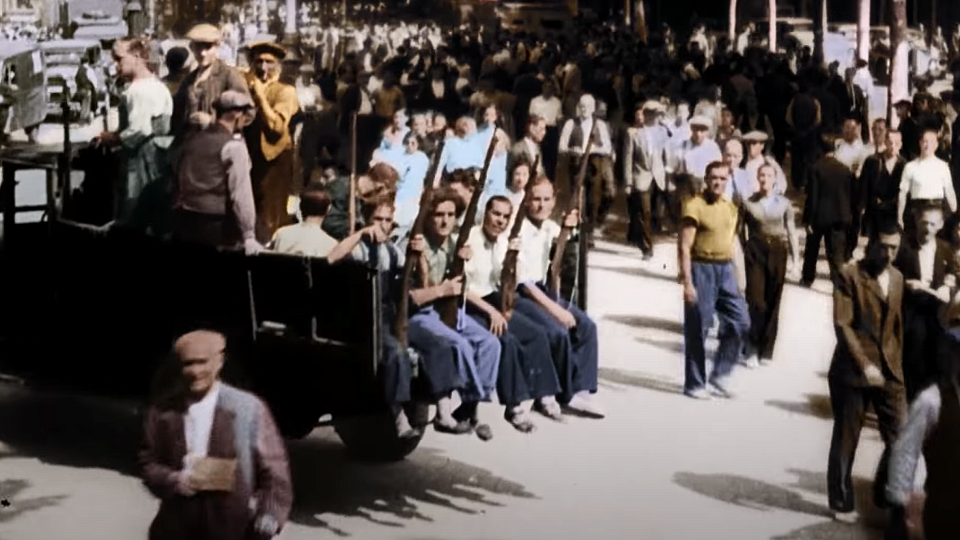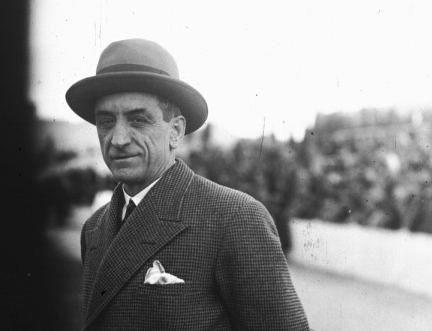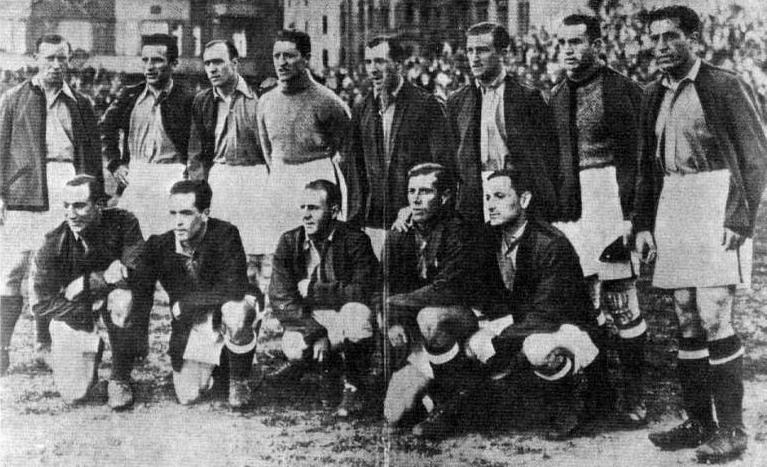History of the National Team (Part 7): The Civil War years

1936-1939: a period of three years that marked the end of one era and the start of another in our country also left its mark on the history of the Spanish national football team. The Civil War was a multidimensional tragedy, affecting all aspects of life, from national, international, personal, family, political, socio-economic, cultural, as well as, sporting. It marked a before and after point for the country; and for the national team it was no exception.
When it comes to the history of the National Team, it is clear that the first main period that began with the creation of the team in 1920 for the Antwerp Olympic Games came to an abrupt end with the outbreak of war. A dark period then began, marked by the confrontation that took place on Spanish soil and by the subsequent Second World War (1939-45). This was a period in which no official matches were played between 1936 and 1939, and subsequently very few were played during the Second World War years (1939-45).
The Civil War also led to the violent death of national team players such as Monchín Triana and the exile of others such as Ricardo Zamora, José Padrón, Luis Regueiro and Isidro Lángara. Some internationals took an active part in the conflict: Gorostiza enlisted in the Ortiz de Zárate Requeté Tercio Brigade, where he fought on the Teruel front; Eduardo González Valiño, commonly known as Chacho, was an artillery soldier; and Guillermo Eizaguirre served as a nationalist soldier, reaching the rank of captain in the Legion.
The long and bloody Civil War had at least three direct consequences on the Spanish national football team, which was only 16 years old at the time of the outbreak.
Led by coach Amadeo García Salazar, the team they fielded included the two great defenders of the day, Ciriaco and Quincoces, as well as first team regulars Ipiña, Epi, Campanal and Chacho. The two matches against Portugal ended in victories for the Portuguese, with the scores 2-1 and 1-0 respectively.
Against Portugal on 28 November 1937, Eizaguirre; Ciriaco, Quincoces; Aranaz, Vega, Ipiña; Epi, Gallart, Vergara, Chacho and Vázquez all started the match. On 30 January 1938, 16 players travelled to Lisbon. The squad was comprised of Eizaguirre and Inchausti as goalkeepers, Ciriaco, Quincoces and Zabala as defenders, while Aranaz, Germán, Soladrero and Peral went as midfielders, as well as Epi, Saro, Campanal, Vergara, Agustín, Herrerita and Vázquez completing the squad’s forward positions. Also part of the travelling party were coach Ramón Encinas, the masseur Birichinaga and the vice-president of the Federation Juan López García.
Amadeo García Salazar
In addition to those international matches, at the end of 1937, the national team managed by Ramón Encinas toured Andalusia, where they played in Granada, Cádiz and Seville. The senior national team also played two more matches in Ceuta in 1938, firstly on Sunday 6 February 1938 at the Municipal Stadium in Ceuta and then again on the 13th of the same month at the Hípica de Tetuán against a Spanish-Moroccan team.
After a tour full of setbacks, the national team played a match on 6 February 1938 and beat the Spanish-Moroccan Federation 3-1. The national team took the field wearing a green shirt and blue shorts and the goals were scored by Vergara (2) and Campanal, while Ferre scored for the home side.
On 13 February, the rematch was played at the Estadio de la Hípica de Tetuán and the national team won again, this time by a larger margin (5-2), with goals from Campanal (2), Epi and Vergara (2) for the national team while Tatono and Torrontegui scored for the North African side.
Republican Spain’s national team: Euskadi
At the same time, in Republican Spain, a team of Basque players formed the Euskadi team, with household names such as Luis Regueiro as captain and team spokesman. In addition, other internationals, the backbone of the previously unified Spanish national team in the 1930s, formed part of that team: Blasco, Ricardo Zamora's understudy, Cilaurren, Muguerza, Pedro Regueiro, Lángara, Iraragorri and Emilín.
They went on a journey that would turn into an exciting adventure: playing two matches across two continents.
The first stop was France, where they played Racing de Paris at the Parc des Princes. After visiting Toulouse and Marseille, they went on to Czechoslovakia, the USSR, Norway and Denmark. The tour then continued on to The Americas, where they would play in Mexico and Cuba, but not to Argentina as planned, due to that part of the tour frustratingly falling through. That touring side ended up playing in the Mexican League in the 1938-39 season as Club Deportivo Euzkadi, finishing as runners-up in the league.
This was not to be the only occasion when Mexican football would welcome Spanish players.
The career of Spain international Martin Ventolrà, like that of many other FC Barcelona players, took a turn for the worse with the outbreak of war. The Catalan team, with serious financial problems, toured Mexico and the United States to raise funds, setting off for America on 17 May 1937 and not returning until October. But Ventolrà, while in the port of Veracruz and already aboard the ship home, changed his mind. This is how his son Martín recalled the event to the newspaper Sport:
“As they were about to set sail, Baltasar Junco, one of the owners of Club España, and Agustín 'Escopeta' González (a radio journalist who famously narrated matches at a breakneck speed) appeared and the conversation went more or less like this:
-Martín, are you staying in Mexico? We'll offer you a contract! shouted Junco.
-If you get my luggage off the boat, I'll stay! my father replied."
Journalist and writer Julián García Candau illustrates that in the match against Portugal in 1937, "two large portraits of Franco and Oliveira Salazar presided over the game".
"Flags of the Falange (Spanish fascist party) were placed in the stands. In the royal box were the military commander of Vigo, Felipe Sánchez, the former Portuguese Minister of War and the Portuguese ambassador in Berlin. Before kick-off, in order to give greater patriotic importance to the national anthems, the songs were played with arms outstretched in the fascist salute. Furthermore, the Portuguese legionnaires attending the match shouted three times:
Salazar, Salazar, Salazar, Salazar!
Franco! Franco! Franco! Franco!
Portugal! Portugal! Portugal! Portugal!
Spain! Spain! Spain! Spain!
Long live Portugal! Long live Spain!"
If war is a way of doing politics by other means (Clausewitz), then football, at times, has also been another way of doing politics throughout recent history . The "Spanish national team" on the nationalists side, and the Euskadi team for the Republicans ended up being instruments of propaganda and ideological or nationalist identity at the service of the different regimes, as well as a source of financing. Through the image provided by football and the two supposed national teams, the aim was to obtain international recognition and visibility beyond Spanish borders. The aim was also to promote the "republican" and "nationalist" causes by attracting sympathy and economic support.
Two Spanish teams, two different kits
"The nationalists’ team wore blue, the colour of the Falange, and not the typical Spanish red, which was seen as the enemy's colour; while the Euskadi team (the closest to what one might consider a national team in Republican Spain) wore the red, white and green colours of the ikurriña."
The particular case of the Euskadi side
The Euskadi team was promoted by the Basque José Antonio Aguirre, who had been a football player in the 1920s with Athletic Club.
For their part, the Euskadi players, many of them former internationals with the Spain national team, became defenders of the cause, in this case the republican cause, and of an identity, the Basque identity.
As for the defence of republican ideals and the Second Republic as a regime, Luis Regueiro (25-time international and the captain of the Euskadi team) became a defender of the work of the autonomous government and, while in Paris, acted as its spokesman:
"In the Basque Country, as you know, the churches are open for worship and the faithful will attend them as long as peace lasts. We ourselves are deeply Catholic people. Our mission is purely humanitarian and peaceful (...); the Basque people wish above all to humanise the war, to avoid all pointless evils, to prevent the pains of war from reaching women and children and causing the ruin of the civilian population".
On the other side, the "Spanish team", or the nationalist team, was supported by the Franco regime as a way of strengthening ties with the Allies, gaining an international presence and breaking out of isolation. Proof of the intense politicisation was that the national team wore blue, the colour of the Falange, and not red, the enemy's colour, while the Euskadi team wore the colours of the ikurriña.
This progression was interrupted in 1936 and would not resume until 1941, although a full fixture list would not really come back in its entirety until 1945, after the end of the Spanish Civil War in 1939 and the Second World War six years later.
During this period, Guillermo Eizaguirre, the man who had been destined to replace Zamora, retired, among others, and Luis Regueiro and Lángara, who returned to play his later years with Real Oviedo, went into exile.
With another great generation led by Telmo Zarraonaindia, commonly known as ‘Zarra’, the national team would return to the elite of world football, although Spain would have to wait until the 1950 World Cup in Brazil.

